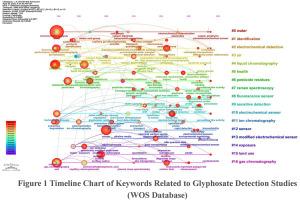环境监测中草甘膦残留分析的进展:从色谱法到免疫分析法
IF 4.9
2区 化学
Q1 CHEMISTRY, ANALYTICAL
引用次数: 0
摘要
草甘膦是使用最广泛的除草剂,其环境残留对生态和人类健康造成重大风险。本文综述了各种先进的草甘膦检测技术,包括色谱法、光谱法和电化学分析,同时评价了它们的优势和局限性。离子色谱法采用大容量色谱柱和氨型膜抑制剂,在饮用水中检出限为0.03 μg/L,回收率为91% ~ 118%,但受NO₂−和SO₄2−等盐的干扰。FMOC-cl衍生化后的高效液相色谱法在0.6 μg/L的海水中检测到草甘膦,但衍生化步骤使相对标准偏差(RSD)增加到5% - 8%。液相色谱-串联质谱(LC-MS/MS)在土壤中的检出限低至0.5 μg/L, RSD < 3%,具有较强的抗基质干扰能力,无需衍生化。荧光分光光度法的检测范围在纳摩尔尺度,由于环境pH值的波动,荧光强度可能会出现10% - 15%的偏差。表面增强拉曼光谱,使用半胱氨酸修饰的纳米银,将检测限降低到1毫米,但面临信号不稳定。基于Fe₃O₄纳米酶的光电化学传感器在5 × 10−10 - 1 × 10−4 M范围内检测,回收率为95.9% - 104.5%,但电极活性每月衰减15%。未来的研究应着眼于优化色谱柱,整合多种技术,并采用纳米材料来提高灵敏度、准确性和环境适应性本文章由计算机程序翻译,如有差异,请以英文原文为准。

Advances in glyphosate residue analysis for environmental monitoring: From chromatography to immunoassays
Glyphosate, the most widely used herbicide, poses significant ecological and human health risks due to its environmental residues. This paper reviews various advanced techniques for glyphosate detection, including chromatographic methods, spectroscopic techniques, and electrochemical analysis, while evaluating their strengths and limitations. Ion chromatography, using large-capacity columns and ammonium-type membrane suppressors, achieves a detection limit of 0.03 μg/L in drinking water, with recovery rates ranging from 91 % to 118 %, but suffers from interference by salts like NO₂− and SO₄2−. High-performance liquid chromatography, following FMOC-cl derivatization, detects glyphosate at 0.6 μg/L in seawater, though the derivatization step increases the relative standard deviation (RSD) to 5 %–8 %. Liquid chromatography-tandem mass spectrometry (LC-MS/MS), without derivatization, achieves a detection limit as low as 0.5 μg/L in soil, with an RSD under 3 %, providing strong resistance to matrix interference. Fluorescence spectrophotometry, with a detection range in the nanomolar scale, can experience 10 %–15 % deviations in fluorescence intensity due to environmental pH fluctuations. Surface-enhanced Raman spectroscopy, using cysteamine-modified silver nanoparticles, lowers the detection limit to 1 mM but faces signal instability. Photoelectrochemical sensors with Fe₃O₄ nanoparticle-based nanozymes detect within the range of 5 × 10−10–1 × 10−4 M, with recovery rates of 95.9 %–104.5 %, but show a 15 % decay in electrode activity per month. Future research should aim to optimize chromatographic columns, integrate multiple techniques, and employ nanomaterials to improve sensitivity, accuracy, and environmental adaptability
求助全文
通过发布文献求助,成功后即可免费获取论文全文。
去求助
来源期刊

Microchemical Journal
化学-分析化学
CiteScore
8.70
自引率
8.30%
发文量
1131
审稿时长
1.9 months
期刊介绍:
The Microchemical Journal is a peer reviewed journal devoted to all aspects and phases of analytical chemistry and chemical analysis. The Microchemical Journal publishes articles which are at the forefront of modern analytical chemistry and cover innovations in the techniques to the finest possible limits. This includes fundamental aspects, instrumentation, new developments, innovative and novel methods and applications including environmental and clinical field.
Traditional classical analytical methods such as spectrophotometry and titrimetry as well as established instrumentation methods such as flame and graphite furnace atomic absorption spectrometry, gas chromatography, and modified glassy or carbon electrode electrochemical methods will be considered, provided they show significant improvements and novelty compared to the established methods.
 求助内容:
求助内容: 应助结果提醒方式:
应助结果提醒方式:


